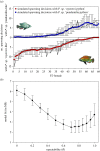The genetics of mate preferences in hybrids between two young and sympatric Lake Victoria cichlid species
- PMID: 28202807
- PMCID: PMC5326523
- DOI: 10.1098/rspb.2016.2332
The genetics of mate preferences in hybrids between two young and sympatric Lake Victoria cichlid species
Abstract
The genetic architecture of mate preferences is likely to affect significant evolutionary processes, including speciation and hybridization. Here, we investigate laboratory hybrids between a pair of sympatric Lake Victoria cichlid fish species that appear to have recently evolved from a hybrid population between similar predecessor species. The species demonstrate strong assortative mating in the laboratory, associated with divergent male breeding coloration (red dorsum versus blue). We show in a common garden experiment, using DNA-based paternity testing, that the strong female mate preferences among males of the two species are fully recovered in a large fraction of their F2 hybrid generation. Individual hybrid females often demonstrated consistent preferences in multiple mate choice trials (more than or equal to five) across a year or more. This result suggests that female mate preference is influenced by relatively few major genes or genomic regions. These preferences were not changed by experience of a successful spawning event with a male of the non-preferred species in a no-choice single-male trial. We found no evidence for imprinting in the F2 hybrids, although the F1 hybrid females may have been imprinted on their mothers. We discuss this nearly Mendelian inheritance of consistent innate mate preferences in the context of speciation theory.
Keywords: Pundamilia nyererei; Pundamilia pundamilia; assortative mating; hybridization; sensory drive; speciation-with-gene-flow.
© 2017 The Author(s).
Figures


Similar articles
-
Sympatry and parapatry among rocky reef cichlids of Lake Victoria explained by female mating preferences.J Evol Biol. 2024 Jan 29;37(1):51-61. doi: 10.1093/jeb/voad006. J Evol Biol. 2024. PMID: 38285657
-
Inheritance of female mating preference in a sympatric sibling species pair of Lake Victoria cichlids: implications for speciation.Proc Biol Sci. 2005 Feb 7;272(1560):237-45. doi: 10.1098/rspb.2004.2946. Proc Biol Sci. 2005. PMID: 15705547 Free PMC article.
-
Disruptive sexual selection on male nuptial coloration in an experimental hybrid population of cichlid fish.Philos Trans R Soc Lond B Biol Sci. 2008 Sep 12;363(1505):2861-70. doi: 10.1098/rstb.2008.0049. Philos Trans R Soc Lond B Biol Sci. 2008. PMID: 18522918 Free PMC article.
-
The diversity of male nuptial coloration leads to species diversity in Lake Victoria cichlids.Genes Genet Syst. 2013;88(3):145-53. doi: 10.1266/ggs.88.145. Genes Genet Syst. 2013. PMID: 24025243 Review.
-
Local variation and parallel evolution: morphological and genetic diversity across a species complex of neotropical crater lake cichlid fishes.Philos Trans R Soc Lond B Biol Sci. 2010 Jun 12;365(1547):1763-82. doi: 10.1098/rstb.2009.0271. Philos Trans R Soc Lond B Biol Sci. 2010. PMID: 20439280 Free PMC article. Review.
Cited by
-
The neurodevelopmental genes alan shepard and Neuroglian contribute to female mate preference in African Drosophila melanogaster.J Evol Biol. 2024 Aug 1;37(8):877-890. doi: 10.1093/jeb/voae074. J Evol Biol. 2024. PMID: 38900077 Free PMC article.
-
Implications of size-selective fisheries on sexual selection.Evol Appl. 2020 Jun 22;13(6):1487-1500. doi: 10.1111/eva.12988. eCollection 2020 Jul. Evol Appl. 2020. PMID: 32684971 Free PMC article.
-
Endless forms of sexual selection.PeerJ. 2019 Nov 5;7:e7988. doi: 10.7717/peerj.7988. eCollection 2019. PeerJ. 2019. PMID: 31720113 Free PMC article.
-
Genetic architecture of a key reproductive isolation trait differs between sympatric and non-sympatric sister species of Lake Victoria cichlids.Proc Biol Sci. 2020 Apr 8;287(1924):20200270. doi: 10.1098/rspb.2020.0270. Epub 2020 Apr 8. Proc Biol Sci. 2020. PMID: 32259470 Free PMC article.
-
Inbreeding load and inbreeding depression estimated from lifetime reproductive success in a small, dispersal-limited population.Heredity (Edinb). 2019 Aug;123(2):192-201. doi: 10.1038/s41437-019-0197-z. Epub 2019 Feb 26. Heredity (Edinb). 2019. PMID: 30809076 Free PMC article.
References
-
- Coyne JA, Orr HA. 2004. Speciation. Sunderland, MA: Sinauer.
-
- Nosil P. 2012. Ecological speciation, 280 Oxford, UK: Oxford University Press.
MeSH terms
Associated data
LinkOut - more resources
Full Text Sources
Other Literature Sources
Miscellaneous

